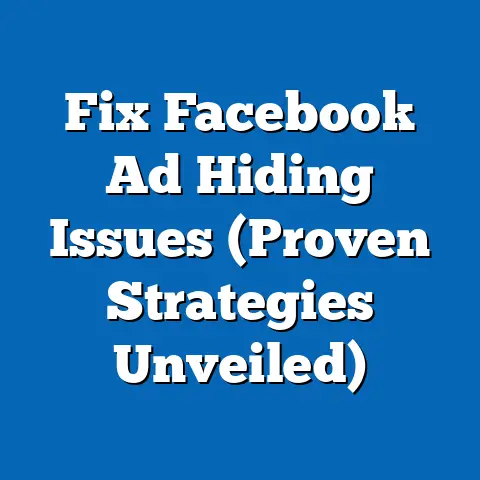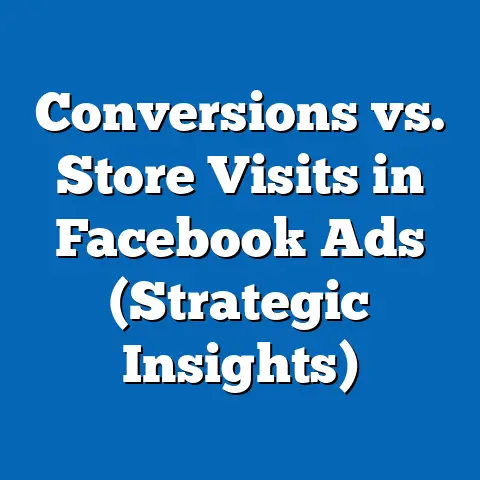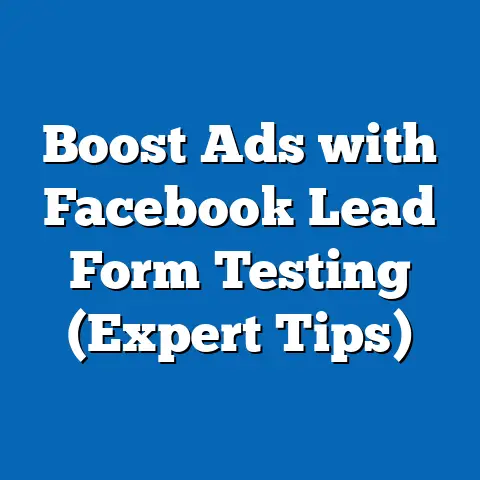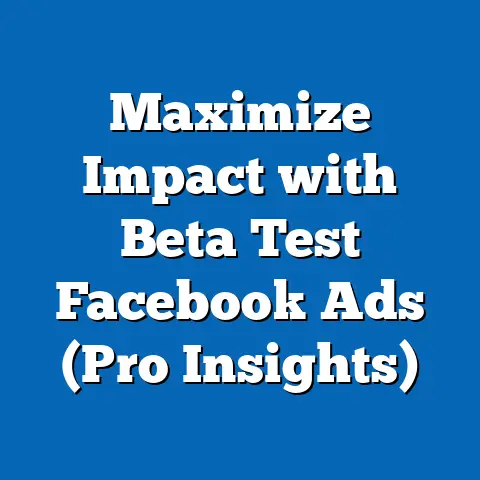Schedule Facebook Ads for Maximum Impact (Timing Secrets)
You know, there’s this classic joke about a guy who’s always fashionably late. He shows up to his own surprise party a day late, claiming he wanted to make a grand entrance. We all chuckle, but let’s be real, in the world of Facebook Ads, being late is no laughing matter. Sending your ad at the wrong time can be like sending a “Hey, what’s up?” text at 3 AM – you might get a response, but it probably won’t be the one you’re hoping for.
Timing is everything, right? It’s the secret sauce that can transform a good ad into a phenomenal one. Just like a comedian nailing the perfect punchline, getting your Facebook ad in front of the right eyes at the right moment can make all the difference between a resounding success and a dismal flop.
In this guide, I’m going to pull back the curtain on the timing secrets that can help you maximize the impact of your Facebook ads. I’ll walk you through understanding your audience’s behavior, decoding the science of timing, identifying the best times to post your ads, mastering the tools for scheduling, and even share some real-world case studies. Let’s dive in and make sure your ads hit their mark every single time!
Understanding Facebook Audience Behavior
Okay, so you’ve got a killer ad ready to go. Awesome! But before you hit that “Publish” button, let’s talk about where your audience is mentally. Are they scrolling through Facebook during their morning commute, sneaking a peek during a lunch break, or unwinding after a long day? Understanding these patterns is crucial.
Think of it like this: You wouldn’t try to sell snow shovels in July, would you? (Unless you’re selling them to people planning a very specific summer vacation.) Similarly, you need to understand when your target audience is most receptive to your message on Facebook.
General Behavior Patterns
Facebook users are creatures of habit, and their online behavior tends to follow predictable patterns. Generally, you’ll find higher engagement rates during:
- Weekdays vs. Weekends: Weekdays often see higher engagement because people are taking breaks at work and checking social media. I’ve personally found that ads targeting professionals perform better during the work week.
- Midday Hours: Lunch breaks and early afternoons are prime time for catching your audience’s attention.
- Evenings: After work, people often relax by browsing Facebook, making this another sweet spot for ad delivery.
However, these are just general guidelines. The real magic happens when you dig deeper and understand how these patterns vary based on demographics.
Demographic Variations
Different demographics have different online habits. For example:
- Parents: Often active early in the morning before the kids wake up or late at night after they’re asleep. I remember running a campaign for baby products and seeing a huge spike in conversions around 5 AM. Talk about dedication!
- Students: Tend to be more active in the evenings and on weekends. I once ran a campaign for a local tutoring service and saw most engagement after school hours and on Saturdays.
- Professionals: As I mentioned before, they are generally active during workdays but might also check Facebook during their commute. I’ve had success targeting them during lunch breaks and evenings.
Statistics and Studies
Don’t just take my word for it! Here are some statistics to back up these observations:
- Sprout Social’s research suggests that the best times to post on Facebook for overall engagement are weekdays between 9 AM and 1 PM.
- HubSpot found that the highest engagement rates often occur on Wednesdays and Thursdays.
- Statista reports that mobile usage peaks in the evening, indicating that mobile ads should be strategically timed.
These numbers are fantastic starting points, but remember, every audience is different. It’s like knowing your friends are most likely to be awake for a late-night Netflix binge – you still need to figure out which night of the week works best for everyone!
Takeaway: Understanding your audience’s general behavior and demographic-specific patterns is the first step to nailing your ad timing. Next up, we’ll decode the science behind why timing matters so much.
The Science of Timing
So, you know when your audience is likely to be online. Great! But why does timing matter so much in the grand scheme of Facebook’s advertising ecosystem? It’s not just about catching people when they’re scrolling; it’s about understanding how Facebook’s algorithms work and how they prioritize ads based on user engagement.
Think of Facebook’s algorithm as a DJ; it knows when to drop the beat for maximum dance floor action! It’s constantly analyzing user behavior, ad performance, and a whole bunch of other factors to determine which ads to show to which users and when.
The Algorithm’s Role
Facebook’s algorithm, at its core, aims to provide the best possible user experience. That means showing users content they’re likely to find interesting and engaging. When it comes to ads, this translates to prioritizing ads that:
- Have High Engagement Rates: Ads that receive a lot of likes, comments, shares, and clicks are seen as more relevant and valuable.
- Align with User Interests: Facebook uses its vast trove of data to understand what users are interested in and shows them ads that match those interests.
- Provide a Positive User Experience: Ads that are annoying, irrelevant, or misleading are penalized.
Timing plays a crucial role in all of these factors. If you show your ad when your audience is most likely to engage with it, you’re more likely to get those likes, comments, shares, and clicks. This, in turn, signals to the algorithm that your ad is valuable and worth showing to more people.
Ad Delivery and Performance
The timing of your ad can significantly impact its delivery and performance in several ways:
- Relevance Score: Facebook assigns a relevance score to each ad based on its expected engagement. Showing your ad at the right time can boost your relevance score, leading to lower costs and better placement.
- Cost Per Click (CPC): When your ad is shown at a time when your audience is most active, you’re likely to see a higher click-through rate (CTR), which can lower your CPC.
- Conversion Rate: Getting your ad in front of the right people at the right time can dramatically improve your conversion rate.
The Vicious Cycle (and How to Avoid It)
Here’s where things can get tricky. If you show your ad at the wrong time, you’re likely to see low engagement rates. This signals to the algorithm that your ad isn’t valuable, leading to lower relevance scores, higher costs, and ultimately, poor performance. It’s a vicious cycle!
But don’t worry, I’m here to help you break free. By understanding the science of timing and strategically scheduling your ads, you can avoid this pitfall and create a virtuous cycle of high engagement, low costs, and stellar performance.
Takeaway: Timing isn’t just about convenience; it’s a fundamental aspect of how Facebook’s algorithm works. By aligning your ad delivery with your audience’s behavior, you can boost your relevance score, lower your costs, and improve your overall campaign performance.
While I’ve emphasized the importance of knowing your specific audience, there are some general guidelines and industry research that can point you in the right direction.Imagine selling ice cream at dawn—delicious but not exactly a booming business! Knowing when to offer your product or service is just as important as knowing who to offer it to.
General Guidelines
Based on various studies and my own experience, here are some general recommendations for the best times to post Facebook ads:
- Weekdays (Tuesday, Wednesday, Thursday): These days tend to see higher engagement rates compared to Mondays and Fridays. People are generally more focused and active on social media during the middle of the week.
- 9 AM – 1 PM: This timeframe often coincides with lunch breaks and early afternoons, when people are likely to take a break from work and check their social media feeds.
- Evenings (7 PM – 10 PM): After work, people often unwind by browsing Facebook, making this another opportune time to catch their attention.
B2B vs. B2C
It’s essential to consider whether your business is B2B (business-to-business) or B2C (business-to-consumer). Their timing strategies are different:
- B2B: If you’re targeting professionals, focus on weekdays during business hours. Lunch breaks (11 AM – 1 PM) can be particularly effective. I’ve seen great results targeting B2B audiences on LinkedIn during these hours, and the same principles apply to Facebook.
- B2C: If you’re targeting consumers, evenings and weekends can be your best bet. People are more likely to be relaxed and receptive to your message during these times.
Breaking it Down by Industry
The best times to post can also vary by industry. Here are some examples:
- Retail: Weekends and evenings, especially around holidays and special events. I remember running a campaign for a clothing store during Black Friday and seeing a massive spike in sales.
- Food and Beverage: Lunchtime and dinner time, as people are thinking about what to eat. I once ran a campaign for a local restaurant and saw a huge increase in reservations during these hours.
- Education: After school hours and weekends, when students are looking for resources and opportunities.
- Health and Wellness: Early mornings and evenings, when people are focused on their health and fitness goals. I’ve seen success targeting this audience with motivational content and workout tips during these times.
Example Timing Scenarios
Let’s look at some practical examples of how you might apply these timing tips:
- Scenario 1: Promoting a Webinar for Small Business Owners
- Best Days: Tuesday, Wednesday, Thursday
- Best Times: 11 AM – 1 PM (lunch break), 5 PM – 7 PM (after work)
- Scenario 2: Selling Discounted Movie Tickets
- Best Days: Friday, Saturday, Sunday
- Best Times: 6 PM – 9 PM (before the movies)
- Scenario 3: Advertising a New Fitness App
- Best Days: Monday, Tuesday, Wednesday
- Best Times: 6 AM – 8 AM (before work), 6 PM – 8 PM (after work)
- Best Days: Tuesday, Wednesday, Thursday
- Best Times: 11 AM – 1 PM (lunch break), 5 PM – 7 PM (after work)
- Best Days: Friday, Saturday, Sunday
- Best Times: 6 PM – 9 PM (before the movies)
- Best Days: Monday, Tuesday, Wednesday
- Best Times: 6 AM – 8 AM (before work), 6 PM – 8 PM (after work)
Takeaway: While general guidelines and industry research can be helpful, the best way to determine the optimal timing for your Facebook ads is to test and analyze your results. Keep experimenting and adjusting your schedule based on what works best for your specific audience.
Tools and Techniques for Scheduling Ads
Okay, so you’ve got a solid understanding of when to post your ads. Now, let’s talk about how to actually schedule them. Fortunately, Facebook provides a variety of tools and features within Ads Manager that can help you automate the process and optimize your timing strategy.
It’s like showing up to a potluck with a salad when everyone else brought dessert! You don’t want to be the one manually posting ads at all hours of the day and night. Let’s explore the tools that can help you avoid that scenario.
Facebook Ads Manager
The primary tool for scheduling your Facebook ads is, of course, Ads Manager. Within Ads Manager, you can set specific start and end times for your campaigns and ad sets. This allows you to target your audience during the hours and days when they’re most active.
Here’s a step-by-step guide:
- Create a Campaign: Start by creating a new campaign or selecting an existing one.
- Create an Ad Set: Within your campaign, create a new ad set. This is where you’ll define your target audience, budget, and schedule.
- Set Your Schedule: In the “Schedule” section of your ad set, you can choose to run your ads continuously or set a specific start and end date.
- Set Ad Scheduling: Choose the “Run ads on a schedule” option to specify the days and times you want your ads to appear.
- Customize Your Schedule: Use the visual calendar to select the days and times you want your ads to run.
A/B Testing
A/B testing, also known as split testing, is a powerful technique for optimizing your ad timing. By creating multiple versions of your ad and showing them at different times, you can determine which schedule yields the best results.
Here’s how to A/B test your ad timing:
- Create Multiple Ad Sets: Within your campaign, create multiple ad sets with identical targeting and creative.
- Vary the Schedule: Set different schedules for each ad set. For example, one ad set might run from 9 AM to 1 PM, while another runs from 7 PM to 10 PM.
- Monitor Performance: Track the performance of each ad set and identify which schedule yields the highest engagement, lowest costs, and best conversion rates.
- Optimize Your Schedule: Based on your results, adjust your schedule to focus on the times that are most effective for your audience.
Data-Driven Decisions
The key to successful ad scheduling is to make data-driven decisions. Don’t just rely on gut feelings or general guidelines. Instead, use the data from your A/B tests and campaign reports to inform your strategy.
Here are some metrics to track:
- Click-Through Rate (CTR): Measures the percentage of people who see your ad and click on it.
- Cost Per Click (CPC): Measures the cost of each click on your ad.
- Conversion Rate: Measures the percentage of people who complete a desired action after clicking on your ad (e.g., making a purchase, signing up for a newsletter).
- Relevance Score: Provides an estimate of how relevant your ad is to your target audience.
By monitoring these metrics, you can identify patterns and trends that will help you optimize your ad timing.
Takeaway: Facebook Ads Manager provides a robust set of tools for scheduling your ads. By leveraging these tools and employing A/B testing, you can make data-driven decisions and optimize your timing strategy for maximum impact.
Case Studies: Timing in Action
Now that we’ve covered the theory and the tools, let’s take a look at some real-world examples of brands that have successfully leveraged timing to boost their ad performance. These case studies will illustrate how timing can make a tangible difference in your campaign results.
Let’s consider a comically disastrous timing fail: Imagine a company that sells emergency preparedness kits running their ads during a peaceful, sunny day with no news of any impending disasters. It’s like trying to sell umbrellas on a cloudless day—not exactly the most compelling offer!
Case Study 1: E-commerce Brand
- The Challenge: An e-commerce brand selling clothing was struggling to generate sales through their Facebook ads. They were running their ads continuously, without considering the timing.
- The Solution: They decided to conduct A/B testing to determine the best times to post their ads. They created multiple ad sets, each with a different schedule. They tested weekdays vs. weekends, as well as different times of day.
- The Results: They discovered that their ads performed best on weekends, particularly on Saturday afternoons and Sunday evenings. They also found that ads featuring new arrivals performed better during these times.
- The Takeaway: By optimizing their ad timing, they were able to increase their sales by 30% and lower their cost per acquisition by 20%.
Case Study 2: Local Restaurant
- The Challenge: A local restaurant wanted to increase reservations through their Facebook ads. They were targeting people within a 5-mile radius of their restaurant.
- The Solution: They decided to focus their ads on lunchtime and dinner time. They created ads featuring their lunch and dinner menus and scheduled them to run from 11 AM to 1 PM and from 5 PM to 7 PM, respectively.
- The Results: They saw a significant increase in reservations during these times. They also found that ads featuring special promotions, such as discounted appetizers or desserts, performed particularly well.
- The Takeaway: By targeting their ads to specific times of day, they were able to reach people when they were most likely to be thinking about where to eat.
Case Study 3: Online Education Platform
- The Challenge: An online education platform wanted to increase sign-ups for their courses. They were targeting students and professionals who were looking to improve their skills.
- The Solution: They decided to focus their ads on after school hours and weekends. They created ads featuring their course offerings and scheduled them to run from 3 PM to 6 PM on weekdays and from 10 AM to 2 PM on weekends.
- The Results: They saw a significant increase in sign-ups during these times. They also found that ads featuring testimonials from satisfied students performed particularly well.
- The Takeaway: By targeting their ads to specific times of day and days of the week, they were able to reach people when they were most likely to be looking for educational opportunities.
Analyzing the Success Factors
What do these case studies have in common? They all demonstrate the power of timing in Facebook advertising. By understanding their audience’s behavior and strategically scheduling their ads, these brands were able to achieve significant improvements in their campaign performance.
Takeaway: These case studies highlight the importance of data-driven decision-making and continuous optimization. By testing different schedules and analyzing your results, you can identify the timing strategies that work best for your business.
Conclusion
So, there you have it! The secrets to scheduling Facebook ads for maximum impact. We’ve covered everything from understanding your audience’s behavior to mastering the tools for scheduling and analyzing real-world case studies.
Remember that timing is not just about convenience; it’s a fundamental aspect of how Facebook’s algorithm works. By aligning your ad delivery with your audience’s behavior, you can boost your relevance score, lower your costs, and improve your overall campaign performance.
As a final light-hearted note, remember that initial joke about the fashionably late guy? Well, in the world of Facebook Ads, you don’t want to be that guy. You want to be the one who shows up right on time, with the perfect message, ready to make a lasting impression.
Now, go forth and conquer the world of Facebook advertising! Take your newfound knowledge and apply it to your campaigns. Remember that even the best ads need to arrive at the right moment. Good luck, and may your ads always be perfectly timed!






